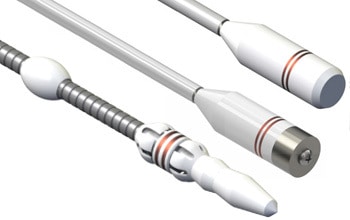Eddy Current Probe Selection: How to Find the Best Probe for Your Application

Whether you are involved in maintenance, inspection, or even procurement, eddy current selection should be more than just a reorder from the supplier or selecting lowest-price components from a catalog. Advancements in eddy current probe technology and design merit a closer look at the features/capabilities and benefits. If testing or inspections are frequent and critical activities of your manufacturing or operational activities, it’s well worth your time to reconsider the criteria you use for eddy current probe selection. In the following sections, we highlight capabilities, functionality, and value-added services that lead to better quality inspections, greater efficiency, and longer probe life.
Tubing Probes
Inspections of boilers, condensers, pressure vessels, heat exchangers, and any other equipment involving non-ferromagnetic or ferromagnetic tubing materials can be time-consuming and error-prone without the components specifically tailored to the unique requirements of each environment. Advancements in array, rotating, and bobbin probe technology are giving these components longer life, improving the accuracy of detection, and reducing inspection time.
Array Probes
Ideal for detecting circumferential cracks and reducing inspection times by acquiring all the required data (both bobbin and special interest tests) in “one pass” through the tubing. When selecting the correct array probes for your application consider:
- Patented technology that reuses transmit and receive coils to create better coverage per coil density.
- Availability of all standard sizes, as well as options for custom sizing to meet unique inspection needs.
- Ability to negotiate tight tubing radii—2.5 inch (63.5 mm) or bends that exceed 90 degrees.
- Spring-supported centering feet to reduce wear in abrasive environments, such as magnetite.
- Designed with abrasion resistant material for extended life and reduced TCO resulting from fewer probe changes during the course of inspections.
Rotating Probes
Motorize rotating pancake coil (or MRPC) probes complement other eddy current inspection techniques when greater precision is necessary. Ideal for detailed evaluation and flaw sizing of stress-corrosion cracking (SCC) in tubing. Low inspection speeds and fragility of probe heads can be drawbacks. Consider capabilities that will enhance the accuracy and efficiency of inspections, such as:
- Option for 1, 2, or 3 coils, including plus point and pancake coils, in a single probe head.
- Supported by motor units providing consistent rotation rates and motor torque to navigate heads and shafts through restrictive areas of tubing.
- Extension shafts for consistent data collection when motor units cannot get close enough to inspection areas.
- Ability to automatically set tuning parameters and avoid potential damage to the motor unit.
Bobbin probes
Provide quick and accurate inspections of tubing made of non-ferrous materials such as austenitic stainless steel, brass, titanium, copper, brass, or Inconel. Ideal for detecting defects caused by steam erosion, pitting, and cracking, as well as defects located under support plates in shell-and-tube heat exchangers. Bobbin probe capabilities that will deliver a greater return on investment include:
- Spring-supported centering feet and abrasion resistant material for extended life that leads to fewer probe changes, reduced radwaste and dose, and significantly reduced downtime.
- Custom probe configurations for heat exchangers (barnacle scrapers designed with stainless front and back bearings in tubes with impediments), varying permeability tubing, and HVAC tubing with fins.
Surface Array Probes
Ideal for detecting small defects in flat and varying-contour surfaces, surface array probes cover a wide area in a single pass. Applications and materials include irregular nonferromagnetic surfaces; defects in smooth ferromagnetic surfaces; pressure vessels, corrosion or cracking, tanks, and turbine blades; fractures in raised welds and friction stir welds; and delamination and foreign materials in composites. For certain inspections, surface probes can reduce inspection time up to 95% when compared to traditional pencil probes. Look for these capabilities and characteristics that improve inspection accuracy:
- Encoder to accurately identify flaw locations and dimensions.
- Position indicators that ensure the entire area of interest is inspected.
- Ability to conform to the weld surface and detect pitting and surface cracks in any orientation.
- Field-replaceable components to accelerate inspections.
- Durability to inspect thousands of feet of welds before replacement.
Eddy Current Probe Selection: Other Factors to Consider
Although probe technology is the key factor in selecting eddy current probes to meet your testing and inspection needs, we invite you to consider a few additional factors that can assist in eddy current probe selection.
Research, Development, and Industry Experience
Quality and design of eddy current probes are closely tied to the manufacturer’s experience in the industry. Look for manufacturers who have invested decades in research leading to the patented technologies. These manufacturers work closely with clients to develop and refine solutions to address the needs testing and inspection needs of power generation, nuclear, oil and gas, and aerospace.
It’s very likely that some of your inspection requirements are unique. When off-the-shelf or out-of-the-box eddy current probes don’t meet your needs, look for manufacturers with extensive experience creating thousands of different probe designs and solutions. In these instances, the consulting and engineering services lead to optimum probe design—not to mention efficient inspection methods.
Eddy Current Probe Selection: A Holistic Approach
Eddy current selection should be more than just another order of the same components you’ve always used. Innovative eddy current probe technology provide better probability of detection, longer life, and greater inspection efficiency. When selecting eddy current probes, adopt a holistic approach. Consider the heritage of the manufacturer, their investments in research and development, and their ability to apply decades of experience to design custom solutions to meet your unique inspection needs. Your initial investment of time to evaluate manufacturers can lead to invaluable long-term economic and operational benefits.
Zetec has been a trusted name in nondestructive inspections for decades and has become the clear leader in eddy current probe technology. To select the best eddy current probes for your inspection needs, contact Zetec today.





